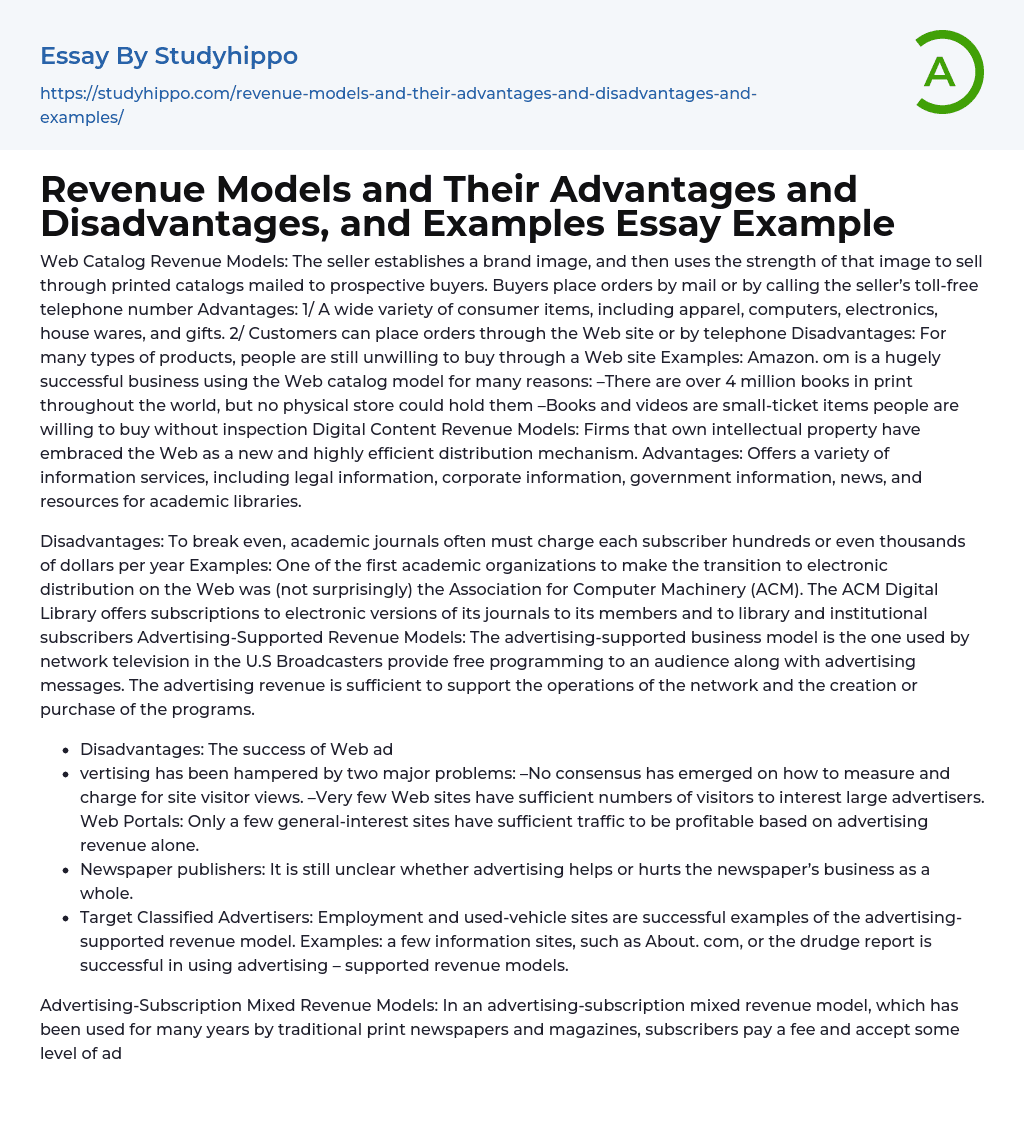

Revenue Models and Their Advantages and Disadvantages, and Examples Essay Example
Web Catalog Revenue Models: The seller establishes a brand image, and then uses the strength of that image to sell through printed catalogs mailed to prospective buyers. Buyers place orders by mail or by calling the seller’s toll-free telephone number Advantages: 1/ A wide variety of consumer items, including apparel, computers, electronics, house wares, and gifts. 2/ Customers can place orders through the Web site or by telephone Disadvantages: For many types of products, people are still unwilling to buy through a Web site Examples: Amazon. om is a hugely successful business using the Web catalog model for many reasons: –There are over 4 million books in print throughout the world, but no physical store could hold them –Books and videos are small-ticket items people are willing to buy without inspection Digital Content Revenue Models: Firms that own intellectual property have embraced the Web as a new and
...highly efficient distribution mechanism. Advantages: Offers a variety of information services, including legal information, corporate information, government information, news, and resources for academic libraries.
Disadvantages: To break even, academic journals often must charge each subscriber hundreds or even thousands of dollars per year Examples: One of the first academic organizations to make the transition to electronic distribution on the Web was (not surprisingly) the Association for Computer Machinery (ACM). The ACM Digital Library offers subscriptions to electronic versions of its journals to its members and to library and institutional subscribers Advertising-Supported Revenue Models: The advertising-supported business model is the one used by network television in the U.S Broadcasters provide free programming to an audience along with advertising messages. The advertising revenue is sufficient to
support the operations of the network and the creation or purchase of the programs.
- Disadvantages: The success of Web ad
- vertising has been hampered by two major problems: –No consensus has emerged on how to measure and charge for site visitor views. –Very few Web sites have sufficient numbers of visitors to interest large advertisers. Web Portals: Only a few general-interest sites have sufficient traffic to be profitable based on advertising revenue alone.
- Newspaper publishers: It is still unclear whether advertising helps or hurts the newspaper’s business as a whole.
- Target Classified Advertisers: Employment and used-vehicle sites are successful examples of the advertising-supported revenue model. Examples: a few information sites, such as About. com, or the drudge report is successful in using advertising – supported revenue models.
Advertising-Subscription Mixed Revenue Models: In an advertising-subscription mixed revenue model, which has been used for many years by traditional print newspapers and magazines, subscribers pay a fee and accept some level of advertising. On Web sites that use the advertising-subscription revenue model, subscribers are typically subjected to much less advertising than they are on advertising-supported site Advantages and disadvantages: 1/ Offer some free content but requires a subscription to access the entire sites. / Allow no subscriber visitors to view the classified ads and certain stories from the newspaper, but most of the content is reserved for subscribers who pay an annual fee for access to the site. Visitors who already subscribe to the print edition are offered a reduced rate on subscriptions to the online edition. Examples: The New York Times and The Wall Street Journal use a
mixed advertising-subscription model. Fee-for-Transaction Revenue Model: Businesses offer services for which they charge a fee that is based on the number or size of transactions they process. Some of these services lend themselves well to operating on the Web.
To the extent that companies can offer Web site visitors the information they need about the transaction, companies can offer much of the personal service formerly provided by human agents. Stock brokerage firms use a fee-for-transaction model. They charge their customers a commission for each trade executed.
- Event Tickets: The Web offers event-promoters an ability to sell tickets from one virtual location to customers practically anywhere in the world.
- Real estate and mortgage loan brokers: Online real estate brokers provide all of the services that a traditional broker might provide. Online banking and financial services: The greatest concerns that most people have when considering moving financial transactions to the Web are security and reliability
- Insurance Brokers: Insurance companies have been slow to offer policies and investments for sale on the Web. A number of intermediaries that sell insurance policies have emerged, for example Quotesmith. com
- Examples: Web sites that offer insurance policy information, comparisons, and sales include: InsWeb, Answer Financial, Insurance. com, and YouDecide. com
- Sales Promotion essays
- Advertising campaign essays
- Advertisement essays
- Advertising essays
- Anheuser-busch essays
- Audience Theory essays
- Brand essays
- Brands essays
- Competitor Analysis essays
- Consumer essays
- Detergent essays
- Marketing Management essays
- Marketing Mix essays
- Marketing Plan essays
- Marketing Research essays
- Marketing Strategy essays
- New Product Development essays
- Point Of Sale essays
- Price essays
- Procurement essays
- Product essays
- Product Differentiation essays
- Product Placement essays
- Promotion essays
- Promotion And Marketing Communications essays
- Research Design essays
- Retailing essays
- Trademark essays
- Aviation essays
- Emergency Management essays
- Health Insurance essays
- Insurance essays
- Life Insurance essays
- Public Transport essays
- Transportation essays
- Administration essays
- Architect essays
- Discipline essays
- Doctor essays
- Engineer essays
- Farmer essays
- Hunter essays
- Labor essays
- Model essays
- Nurse essays
- Pilot essays
- Police Officer essays
- Professionalism essays
- Social Work essays
- Stakeholders essays



